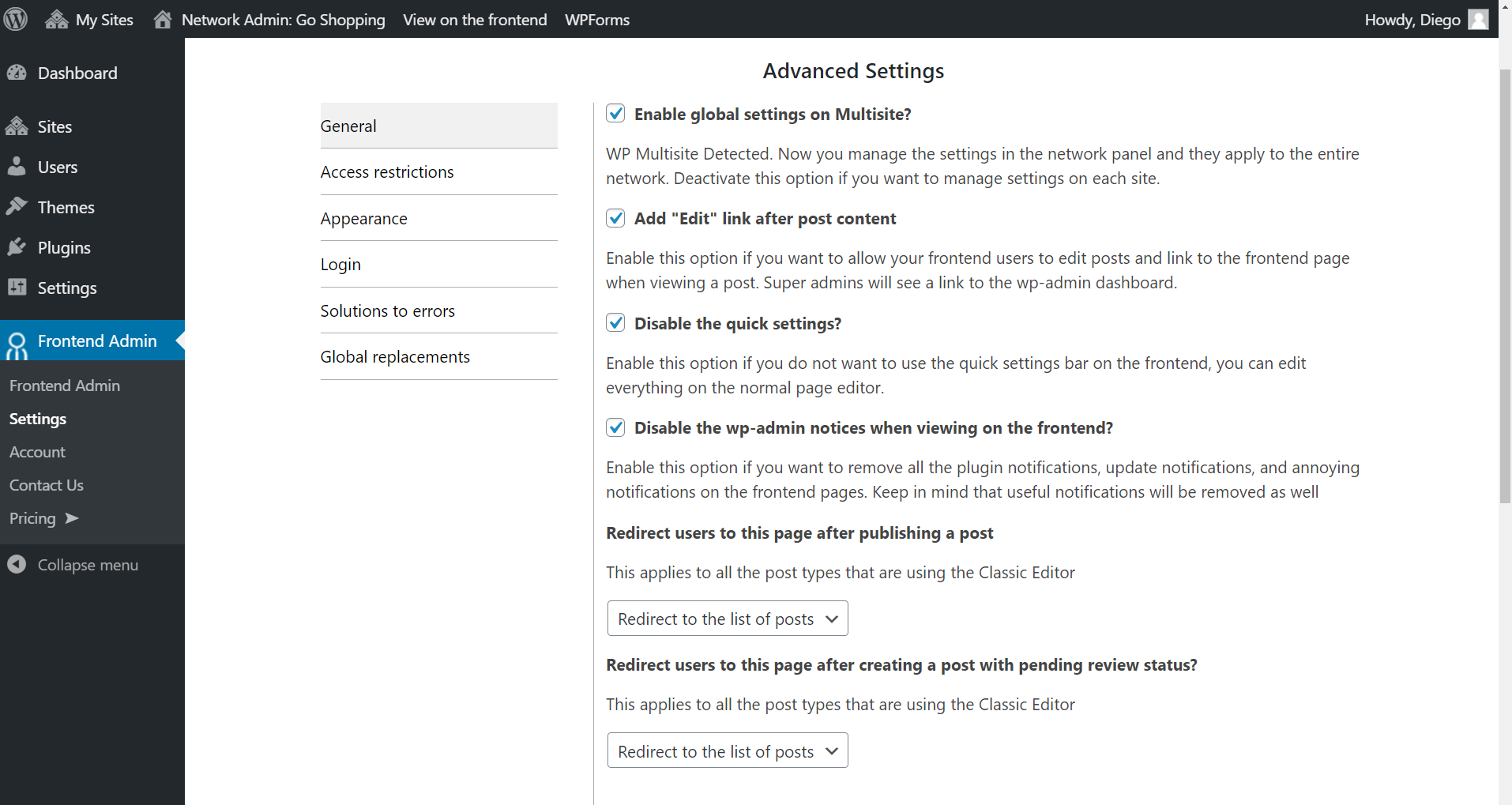This entry is a detailed explanation of the General Settings of the WP Frontend Admin plugin for multisite networks.
Preliminary notes:
- If you use WP Ultimo to sell memberships on your multisite network, you can read our notes on how to integrate WP Frontend Admin and WP Ultimo to build multisite platforms and make money. You’ll learn how to restrict features based on the WP Ultimo plan purchased by the user, how to solve common problems, and many more things.
- You can visit our full list of shortcodes to learn which shortcodes you can use to build your multi-site platform.
Understanding the general settings for Multisite
To open the general settings on multisite, go to Network Admin > Frontend Admin > Settings > General.
Enable global settings on multisite
The access restrictions allow you to better manage the access that users in your network have to the admin pages in the frontend. You can allow access to some pages and restrict it to others.
The access restrictions you select here will apply to all the subsites in your network. Optionally, you can disable this option to manage the WP Frontend Admin settings in each site.
Add “Edit” link after post content
When a user with permissions to edit posts in the frontend reads a post, we will display an “Edit” button under the content of the post. By clicking that button, users will be taken to the post editor in the frontend.
If users do not have permissions to edit posts, the button will not be displayed.
Disable the quick settings
When you create a frontend page, we display a Quick Settings panel on the left side of your screen for you to select the general information of the page (title, slug, template, menu), hide elements, edit texts, etc.
You can check this option to disable the Quick Settings panel; by doing so you will have to select the options in the normal WordPress page editor. Note that this panel will only appear to you as a network administrator. Other users (including subsite administrators) will not see Quick Settings on the frontend pages.
Disable the wp-admin notices when viewing on the frontend
When the administrators of the subsites in your network view frontend pages, they will not see notifications of updates to plugins or themes, or notifications asking you to rate plugins or themes. All notices will be disabled.
However, you should note that important notices will also be disabled.
Redirect users to this page after publishing a post
If users in your network publish posts on their own sites using the editor in the frontend, you can select where to redirect them after they click “Publish”.
- Redirect to the list of posts.
- Redirect to create a new post.
Redirect users to this page after creating a post with pending review status
When users do not have permissions to publish posts and submit them for review, you can decide where you want to redirect them after clicking “Save as pending”.
- Redirect to the list of posts.
- Redirect to create a new post.
Disable the message indicating why a page didn’t load
When network users do not have the necessary permissions to view a frontend page, we will display a message indicating that they need higher permissions. For example, authors can’t edit site settings, so they will see the message indicating why the page didn’t load.
You can disable that message by checking this checkbox.
Hide pages containing our shortcode
When you create a site to use it as a global frontend dashboard (see the last section below), users will have access to the page section of their own sites.
In that case, you can activate this option to hide the pages containing our shortcode from the list of pages that users will see on their sites.
This way, users will not be able to edit the “system/dashboard” pages.
Restrict post types to only display/edit posts created by the current user
In this field, you can enter the keys of the post types that will only show the posts created by the user.
For example, if there is a site in your network where users submit news or articles, it is best that they can only see their own posts and not the posts of all users.
This global option will apply to all subsites. If you enter products, vendors will only see their own products, for example.
WordPress Multisite: Use this site as the frontend dashboard for the entire network
WP Frontend Admin allows you to create a site that works as a global frontend dashboard. This site will contain all the frontend admin pages that users will need to manage their own sites.
Once you have created it, you can select it in this field. This way, users will be redirected here when they try to log in to wp-admin. For example, site administrators will be able to manage their sites from a frontend dashboard like the one shown in the screenshot below.
This is a normal site with frontend admin pages created with a simple shortcode.
You can design your global frontend dashboard as you wish. We have some easy to import designs that you might like.
It is important to mention that the network administrators will continue to use wp-admin to manage the network; but the network sub-site administrators will use the frontend dashboard to manage their sites.



